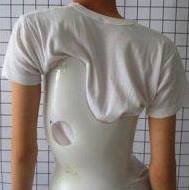The Height of the Axilla Extension is Crucial for Brace Success

Patients with adolescent idiopathic scoliosis are at risk for curve progression and only bracing is effective in preventing it. About 80% of braces made for AIS require an axilla (underarm) extension.
Average correction of thoracic curve in a good brace = 50%
Average distance from thoracic apex to counteractive axilla force = 3.5 inches
Therefore average maximum lever arm at 3.5 in equates to 50% correction, while no lever arm (0 in – counter at same level as thoracic force) = 0% correction
Assuming a linear relationship, every ½ inch below maximum = 7.14% reduction in effectiveness
e.g. a 40-degree curve would be:
3.5in high axilla = 40 x 50% = 20 degrees
3.0in high axilla = 40 x 57.14% = 23 degrees
2.5in high axilla = 40 x 64.28% = 26 degrees
2.0in high axilla = 40 x 71.42% = 29 degrees
**Therefore a brace becomes significantly less effective the lower the axilla extension is and as correction below 30% has been shown to be inadequate, the axilla extension only needs to be 1.5 inches below optimum for the brace to be ineffective.


